Critical Analysis of Safety Issues in the ICU: Nursing Assignment
VerifiedAdded on 2022/09/16
|8
|1611
|20
Essay
AI Summary
This essay provides a critical analysis of safety and legal responsibilities within the Intensive Care Unit (ICU) setting. It explores key issues such as nurse and patient safety, addressing challenges like infection control, staffing concerns, and the emotional well-being of both patients and healthcare professionals. The essay examines the impact of poor performance, medication administration protocols, and the importance of ethical codes and documentation. Furthermore, it delves into evidence-based recommendations for improving safety, including the use of safer needle devices and strategies to mitigate risks. The discussion covers dealing with families, the need for mental fitness, and the importance of a therapeutic relationship. Ultimately, the essay emphasizes the significance of safety in the ICU for enhancing patient outcomes and ensuring a positive working environment for nurses. The reference list includes relevant books and journal articles to support the analysis.
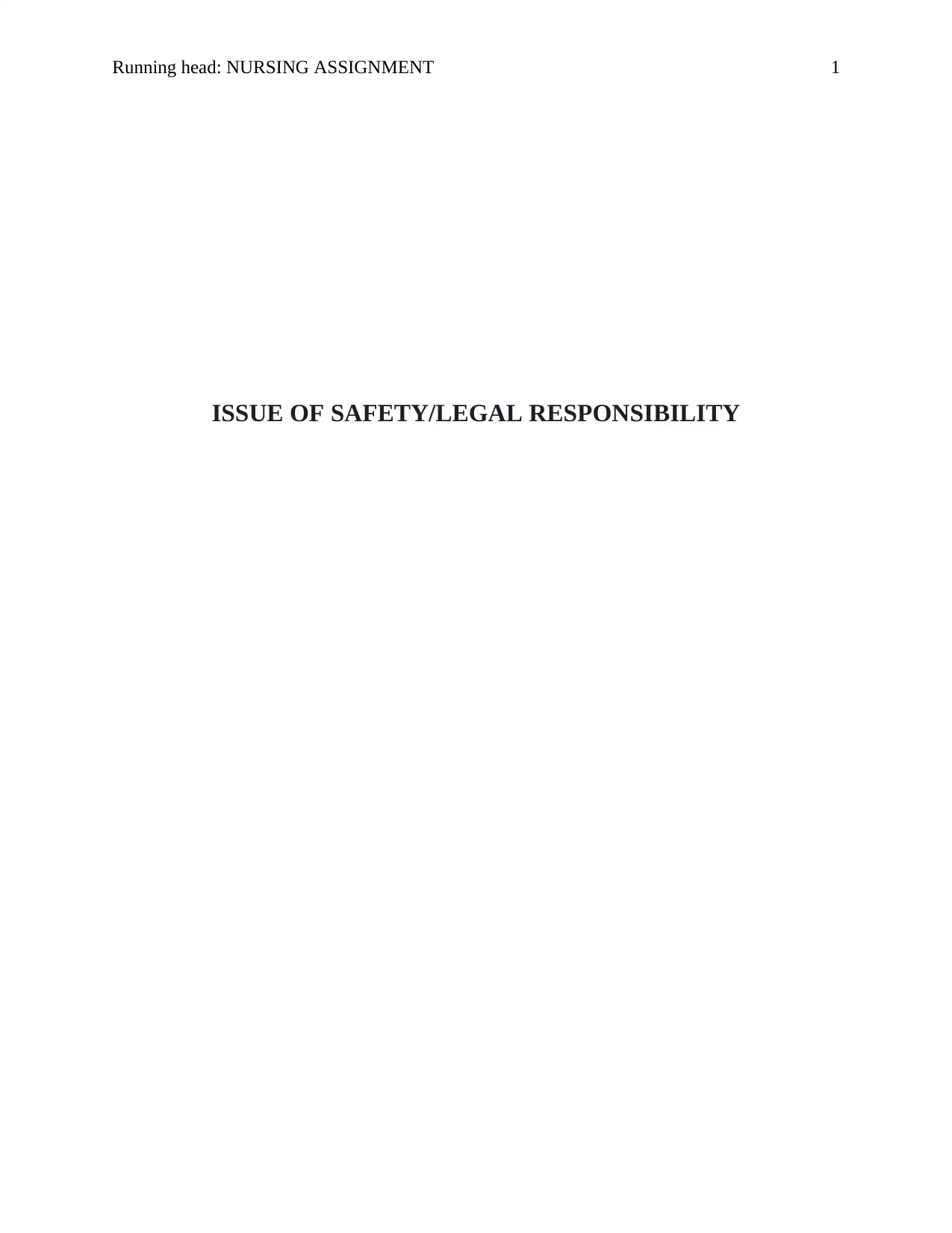
Running head: NURSING ASSIGNMENT 1
ISSUE OF SAFETY/LEGAL RESPONSIBILITY
ISSUE OF SAFETY/LEGAL RESPONSIBILITY
Paraphrase This Document
Need a fresh take? Get an instant paraphrase of this document with our AI Paraphraser
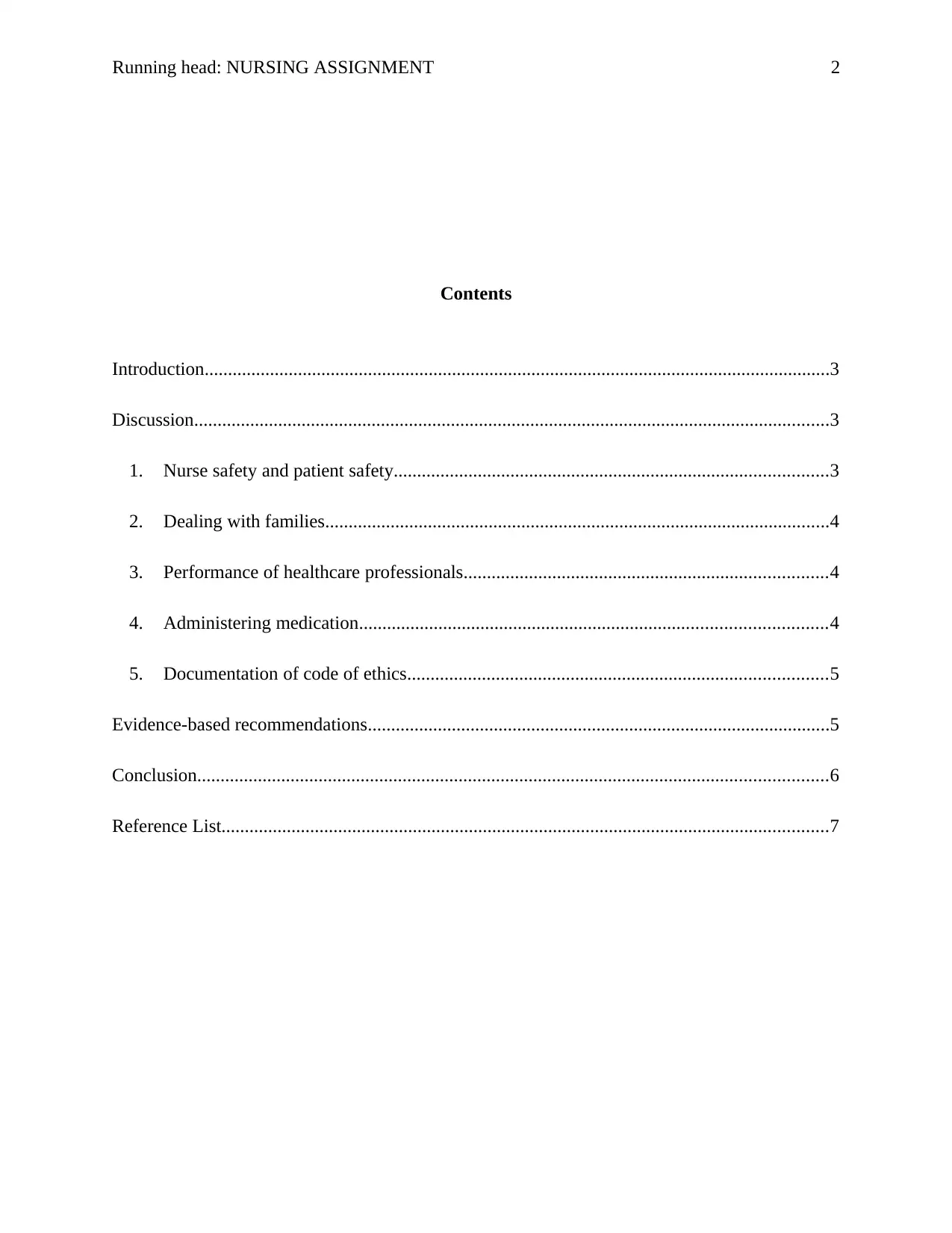
Running head: NURSING ASSIGNMENT 2
Contents
Introduction......................................................................................................................................3
Discussion........................................................................................................................................3
1. Nurse safety and patient safety.............................................................................................3
2. Dealing with families............................................................................................................4
3. Performance of healthcare professionals..............................................................................4
4. Administering medication....................................................................................................4
5. Documentation of code of ethics..........................................................................................5
Evidence-based recommendations...................................................................................................5
Conclusion.......................................................................................................................................6
Reference List..................................................................................................................................7
Contents
Introduction......................................................................................................................................3
Discussion........................................................................................................................................3
1. Nurse safety and patient safety.............................................................................................3
2. Dealing with families............................................................................................................4
3. Performance of healthcare professionals..............................................................................4
4. Administering medication....................................................................................................4
5. Documentation of code of ethics..........................................................................................5
Evidence-based recommendations...................................................................................................5
Conclusion.......................................................................................................................................6
Reference List..................................................................................................................................7
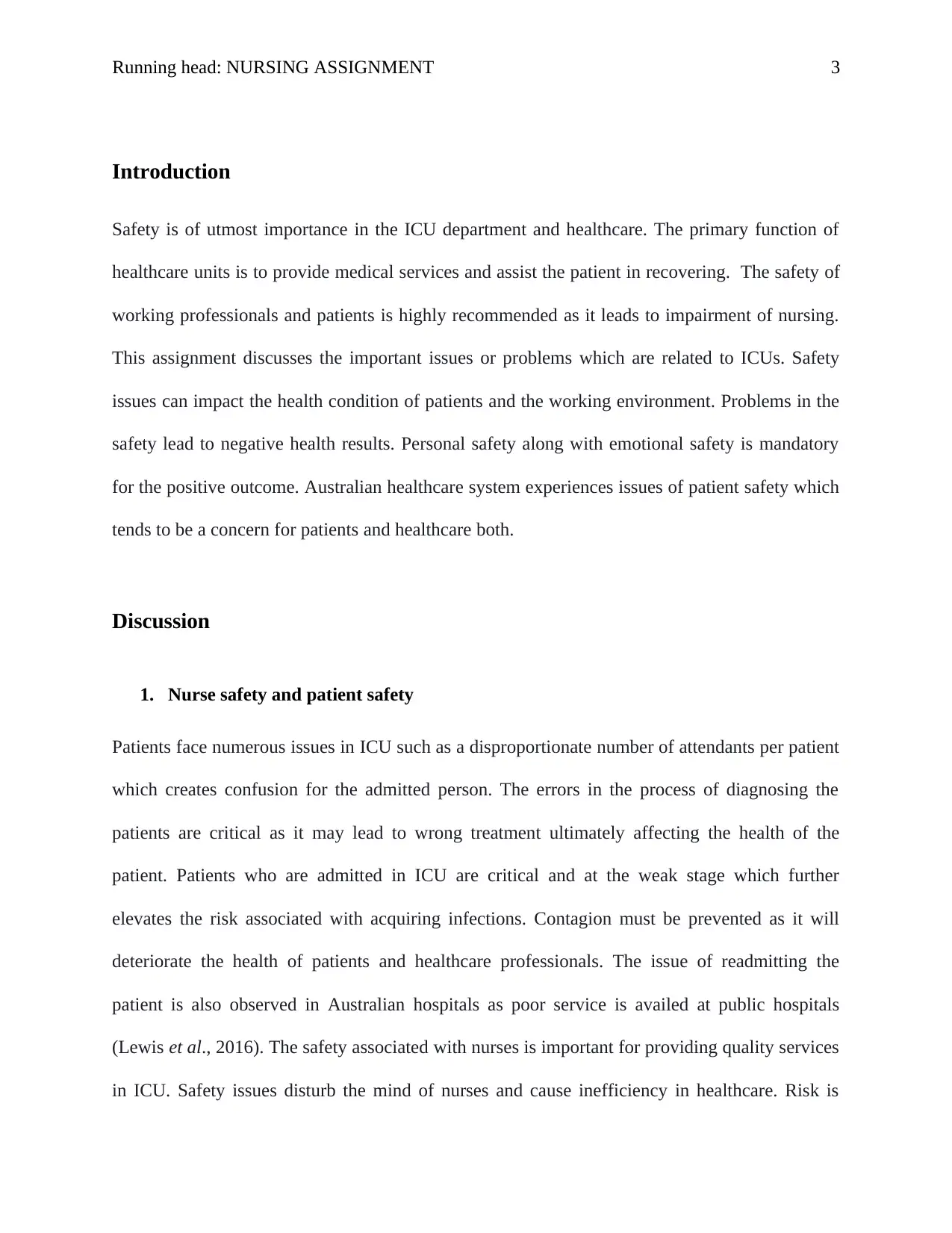
Running head: NURSING ASSIGNMENT 3
Introduction
Safety is of utmost importance in the ICU department and healthcare. The primary function of
healthcare units is to provide medical services and assist the patient in recovering. The safety of
working professionals and patients is highly recommended as it leads to impairment of nursing.
This assignment discusses the important issues or problems which are related to ICUs. Safety
issues can impact the health condition of patients and the working environment. Problems in the
safety lead to negative health results. Personal safety along with emotional safety is mandatory
for the positive outcome. Australian healthcare system experiences issues of patient safety which
tends to be a concern for patients and healthcare both.
Discussion
1. Nurse safety and patient safety
Patients face numerous issues in ICU such as a disproportionate number of attendants per patient
which creates confusion for the admitted person. The errors in the process of diagnosing the
patients are critical as it may lead to wrong treatment ultimately affecting the health of the
patient. Patients who are admitted in ICU are critical and at the weak stage which further
elevates the risk associated with acquiring infections. Contagion must be prevented as it will
deteriorate the health of patients and healthcare professionals. The issue of readmitting the
patient is also observed in Australian hospitals as poor service is availed at public hospitals
(Lewis et al., 2016). The safety associated with nurses is important for providing quality services
in ICU. Safety issues disturb the mind of nurses and cause inefficiency in healthcare. Risk is
Introduction
Safety is of utmost importance in the ICU department and healthcare. The primary function of
healthcare units is to provide medical services and assist the patient in recovering. The safety of
working professionals and patients is highly recommended as it leads to impairment of nursing.
This assignment discusses the important issues or problems which are related to ICUs. Safety
issues can impact the health condition of patients and the working environment. Problems in the
safety lead to negative health results. Personal safety along with emotional safety is mandatory
for the positive outcome. Australian healthcare system experiences issues of patient safety which
tends to be a concern for patients and healthcare both.
Discussion
1. Nurse safety and patient safety
Patients face numerous issues in ICU such as a disproportionate number of attendants per patient
which creates confusion for the admitted person. The errors in the process of diagnosing the
patients are critical as it may lead to wrong treatment ultimately affecting the health of the
patient. Patients who are admitted in ICU are critical and at the weak stage which further
elevates the risk associated with acquiring infections. Contagion must be prevented as it will
deteriorate the health of patients and healthcare professionals. The issue of readmitting the
patient is also observed in Australian hospitals as poor service is availed at public hospitals
(Lewis et al., 2016). The safety associated with nurses is important for providing quality services
in ICU. Safety issues disturb the mind of nurses and cause inefficiency in healthcare. Risk is
⊘ This is a preview!⊘
Do you want full access?
Subscribe today to unlock all pages.

Trusted by 1+ million students worldwide
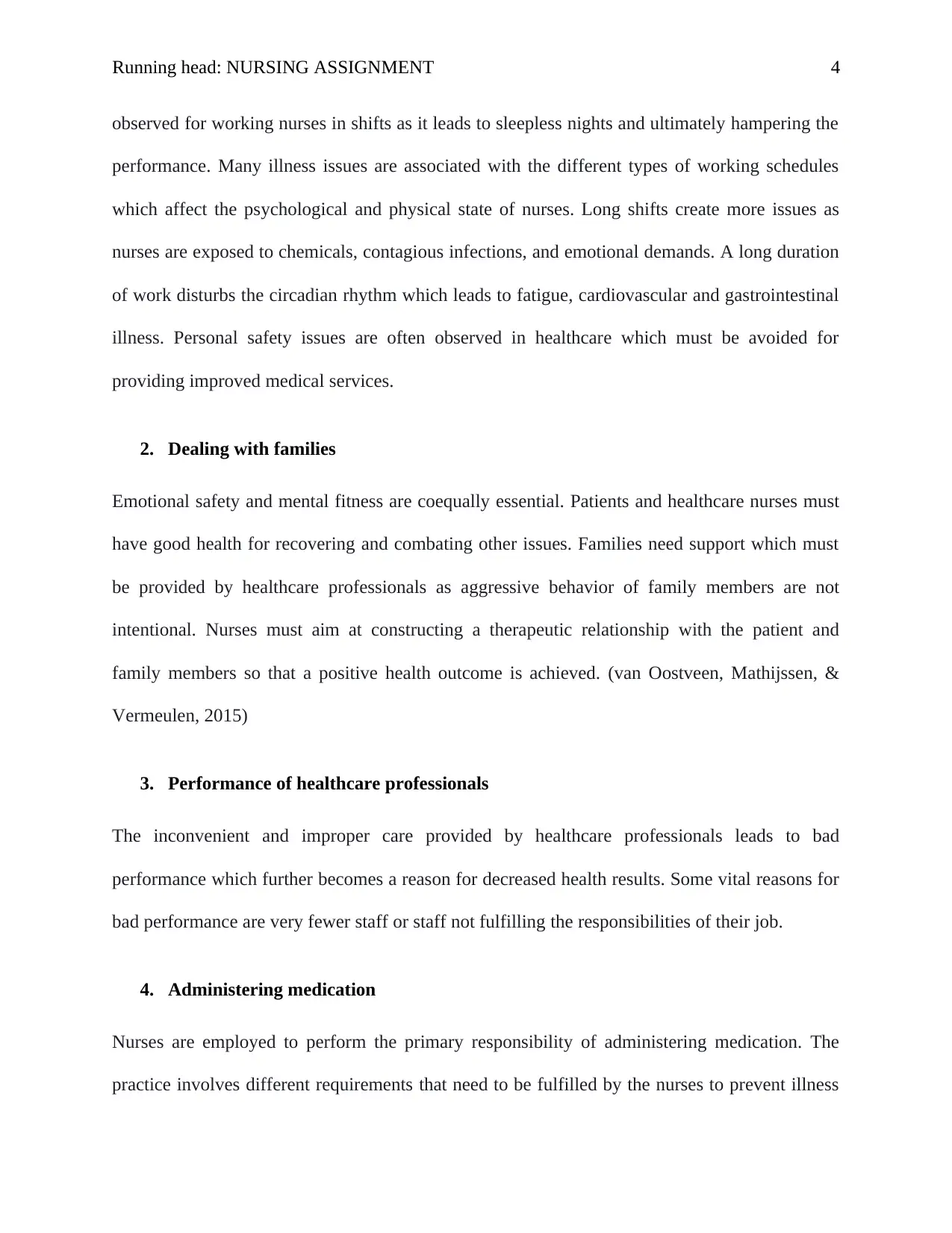
Running head: NURSING ASSIGNMENT 4
observed for working nurses in shifts as it leads to sleepless nights and ultimately hampering the
performance. Many illness issues are associated with the different types of working schedules
which affect the psychological and physical state of nurses. Long shifts create more issues as
nurses are exposed to chemicals, contagious infections, and emotional demands. A long duration
of work disturbs the circadian rhythm which leads to fatigue, cardiovascular and gastrointestinal
illness. Personal safety issues are often observed in healthcare which must be avoided for
providing improved medical services.
2. Dealing with families
Emotional safety and mental fitness are coequally essential. Patients and healthcare nurses must
have good health for recovering and combating other issues. Families need support which must
be provided by healthcare professionals as aggressive behavior of family members are not
intentional. Nurses must aim at constructing a therapeutic relationship with the patient and
family members so that a positive health outcome is achieved. (van Oostveen, Mathijssen, &
Vermeulen, 2015)
3. Performance of healthcare professionals
The inconvenient and improper care provided by healthcare professionals leads to bad
performance which further becomes a reason for decreased health results. Some vital reasons for
bad performance are very fewer staff or staff not fulfilling the responsibilities of their job.
4. Administering medication
Nurses are employed to perform the primary responsibility of administering medication. The
practice involves different requirements that need to be fulfilled by the nurses to prevent illness
observed for working nurses in shifts as it leads to sleepless nights and ultimately hampering the
performance. Many illness issues are associated with the different types of working schedules
which affect the psychological and physical state of nurses. Long shifts create more issues as
nurses are exposed to chemicals, contagious infections, and emotional demands. A long duration
of work disturbs the circadian rhythm which leads to fatigue, cardiovascular and gastrointestinal
illness. Personal safety issues are often observed in healthcare which must be avoided for
providing improved medical services.
2. Dealing with families
Emotional safety and mental fitness are coequally essential. Patients and healthcare nurses must
have good health for recovering and combating other issues. Families need support which must
be provided by healthcare professionals as aggressive behavior of family members are not
intentional. Nurses must aim at constructing a therapeutic relationship with the patient and
family members so that a positive health outcome is achieved. (van Oostveen, Mathijssen, &
Vermeulen, 2015)
3. Performance of healthcare professionals
The inconvenient and improper care provided by healthcare professionals leads to bad
performance which further becomes a reason for decreased health results. Some vital reasons for
bad performance are very fewer staff or staff not fulfilling the responsibilities of their job.
4. Administering medication
Nurses are employed to perform the primary responsibility of administering medication. The
practice involves different requirements that need to be fulfilled by the nurses to prevent illness
Paraphrase This Document
Need a fresh take? Get an instant paraphrase of this document with our AI Paraphraser
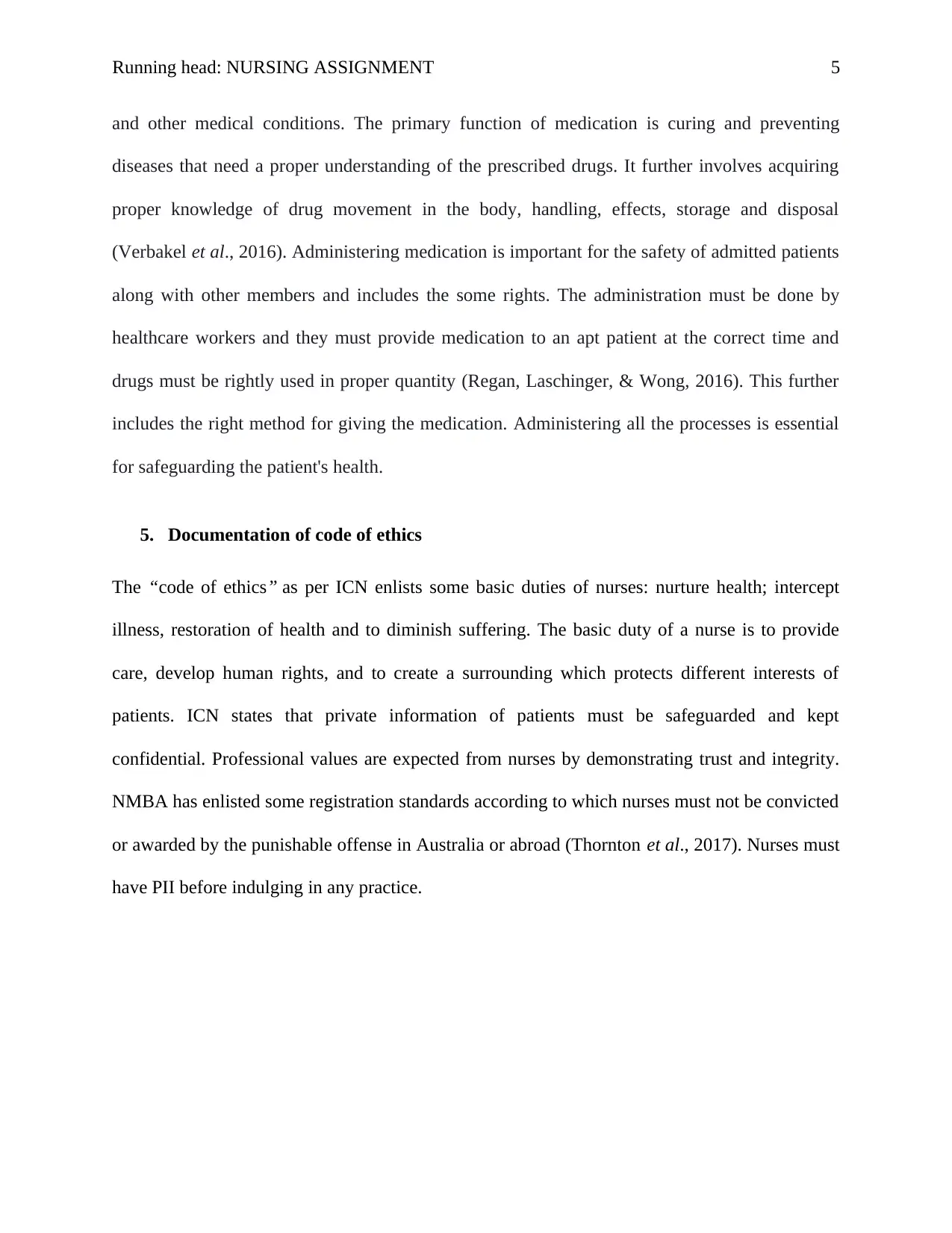
Running head: NURSING ASSIGNMENT 5
and other medical conditions. The primary function of medication is curing and preventing
diseases that need a proper understanding of the prescribed drugs. It further involves acquiring
proper knowledge of drug movement in the body, handling, effects, storage and disposal
(Verbakel et al., 2016). Administering medication is important for the safety of admitted patients
along with other members and includes the some rights. The administration must be done by
healthcare workers and they must provide medication to an apt patient at the correct time and
drugs must be rightly used in proper quantity (Regan, Laschinger, & Wong, 2016). This further
includes the right method for giving the medication. Administering all the processes is essential
for safeguarding the patient's health.
5. Documentation of code of ethics
The “code of ethics” as per ICN enlists some basic duties of nurses: nurture health; intercept
illness, restoration of health and to diminish suffering. The basic duty of a nurse is to provide
care, develop human rights, and to create a surrounding which protects different interests of
patients. ICN states that private information of patients must be safeguarded and kept
confidential. Professional values are expected from nurses by demonstrating trust and integrity.
NMBA has enlisted some registration standards according to which nurses must not be convicted
or awarded by the punishable offense in Australia or abroad (Thornton et al., 2017). Nurses must
have PII before indulging in any practice.
and other medical conditions. The primary function of medication is curing and preventing
diseases that need a proper understanding of the prescribed drugs. It further involves acquiring
proper knowledge of drug movement in the body, handling, effects, storage and disposal
(Verbakel et al., 2016). Administering medication is important for the safety of admitted patients
along with other members and includes the some rights. The administration must be done by
healthcare workers and they must provide medication to an apt patient at the correct time and
drugs must be rightly used in proper quantity (Regan, Laschinger, & Wong, 2016). This further
includes the right method for giving the medication. Administering all the processes is essential
for safeguarding the patient's health.
5. Documentation of code of ethics
The “code of ethics” as per ICN enlists some basic duties of nurses: nurture health; intercept
illness, restoration of health and to diminish suffering. The basic duty of a nurse is to provide
care, develop human rights, and to create a surrounding which protects different interests of
patients. ICN states that private information of patients must be safeguarded and kept
confidential. Professional values are expected from nurses by demonstrating trust and integrity.
NMBA has enlisted some registration standards according to which nurses must not be convicted
or awarded by the punishable offense in Australia or abroad (Thornton et al., 2017). Nurses must
have PII before indulging in any practice.
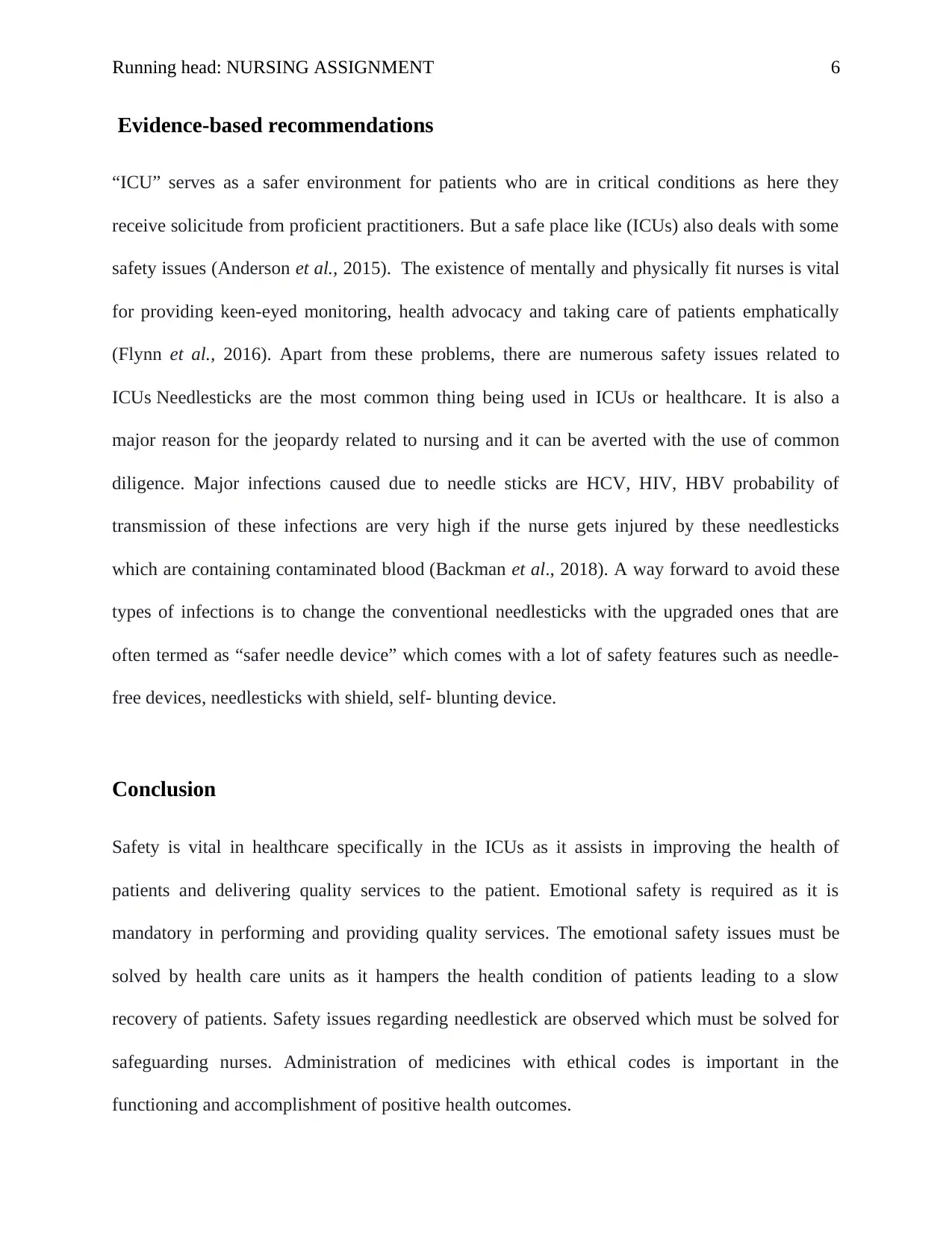
Running head: NURSING ASSIGNMENT 6
Evidence-based recommendations
“ICU” serves as a safer environment for patients who are in critical conditions as here they
receive solicitude from proficient practitioners. But a safe place like (ICUs) also deals with some
safety issues (Anderson et al., 2015). The existence of mentally and physically fit nurses is vital
for providing keen-eyed monitoring, health advocacy and taking care of patients emphatically
(Flynn et al., 2016). Apart from these problems, there are numerous safety issues related to
ICUs Needlesticks are the most common thing being used in ICUs or healthcare. It is also a
major reason for the jeopardy related to nursing and it can be averted with the use of common
diligence. Major infections caused due to needle sticks are HCV, HIV, HBV probability of
transmission of these infections are very high if the nurse gets injured by these needlesticks
which are containing contaminated blood (Backman et al., 2018). A way forward to avoid these
types of infections is to change the conventional needlesticks with the upgraded ones that are
often termed as “safer needle device” which comes with a lot of safety features such as needle-
free devices, needlesticks with shield, self- blunting device.
Conclusion
Safety is vital in healthcare specifically in the ICUs as it assists in improving the health of
patients and delivering quality services to the patient. Emotional safety is required as it is
mandatory in performing and providing quality services. The emotional safety issues must be
solved by health care units as it hampers the health condition of patients leading to a slow
recovery of patients. Safety issues regarding needlestick are observed which must be solved for
safeguarding nurses. Administration of medicines with ethical codes is important in the
functioning and accomplishment of positive health outcomes.
Evidence-based recommendations
“ICU” serves as a safer environment for patients who are in critical conditions as here they
receive solicitude from proficient practitioners. But a safe place like (ICUs) also deals with some
safety issues (Anderson et al., 2015). The existence of mentally and physically fit nurses is vital
for providing keen-eyed monitoring, health advocacy and taking care of patients emphatically
(Flynn et al., 2016). Apart from these problems, there are numerous safety issues related to
ICUs Needlesticks are the most common thing being used in ICUs or healthcare. It is also a
major reason for the jeopardy related to nursing and it can be averted with the use of common
diligence. Major infections caused due to needle sticks are HCV, HIV, HBV probability of
transmission of these infections are very high if the nurse gets injured by these needlesticks
which are containing contaminated blood (Backman et al., 2018). A way forward to avoid these
types of infections is to change the conventional needlesticks with the upgraded ones that are
often termed as “safer needle device” which comes with a lot of safety features such as needle-
free devices, needlesticks with shield, self- blunting device.
Conclusion
Safety is vital in healthcare specifically in the ICUs as it assists in improving the health of
patients and delivering quality services to the patient. Emotional safety is required as it is
mandatory in performing and providing quality services. The emotional safety issues must be
solved by health care units as it hampers the health condition of patients leading to a slow
recovery of patients. Safety issues regarding needlestick are observed which must be solved for
safeguarding nurses. Administration of medicines with ethical codes is important in the
functioning and accomplishment of positive health outcomes.
⊘ This is a preview!⊘
Do you want full access?
Subscribe today to unlock all pages.

Trusted by 1+ million students worldwide
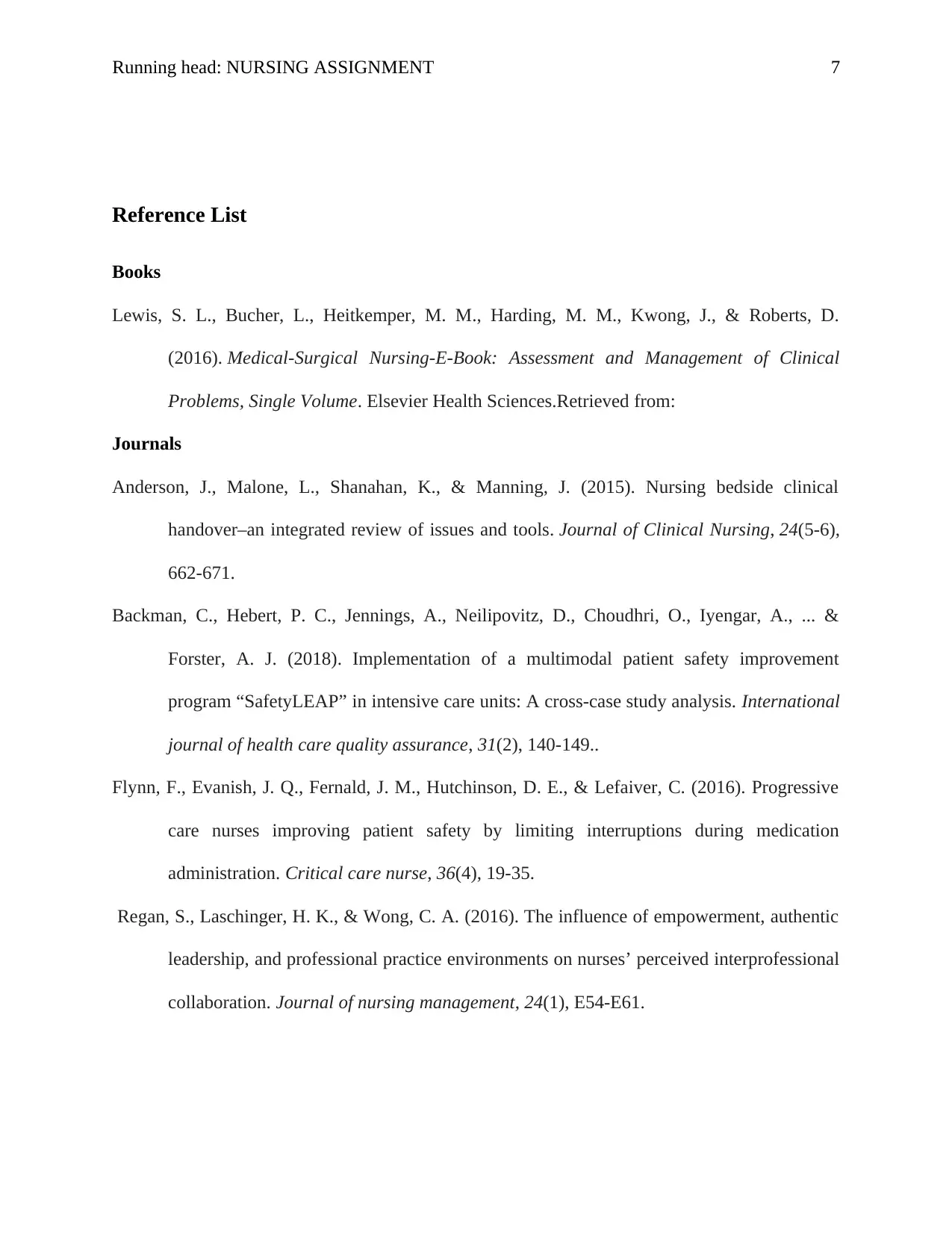
Running head: NURSING ASSIGNMENT 7
Reference List
Books
Lewis, S. L., Bucher, L., Heitkemper, M. M., Harding, M. M., Kwong, J., & Roberts, D.
(2016). Medical-Surgical Nursing-E-Book: Assessment and Management of Clinical
Problems, Single Volume. Elsevier Health Sciences.Retrieved from:
Journals
Anderson, J., Malone, L., Shanahan, K., & Manning, J. (2015). Nursing bedside clinical
handover–an integrated review of issues and tools. Journal of Clinical Nursing, 24(5-6),
662-671.
Backman, C., Hebert, P. C., Jennings, A., Neilipovitz, D., Choudhri, O., Iyengar, A., ... &
Forster, A. J. (2018). Implementation of a multimodal patient safety improvement
program “SafetyLEAP” in intensive care units: A cross-case study analysis. International
journal of health care quality assurance, 31(2), 140-149..
Flynn, F., Evanish, J. Q., Fernald, J. M., Hutchinson, D. E., & Lefaiver, C. (2016). Progressive
care nurses improving patient safety by limiting interruptions during medication
administration. Critical care nurse, 36(4), 19-35.
Regan, S., Laschinger, H. K., & Wong, C. A. (2016). The influence of empowerment, authentic
leadership, and professional practice environments on nurses’ perceived interprofessional
collaboration. Journal of nursing management, 24(1), E54-E61.
Reference List
Books
Lewis, S. L., Bucher, L., Heitkemper, M. M., Harding, M. M., Kwong, J., & Roberts, D.
(2016). Medical-Surgical Nursing-E-Book: Assessment and Management of Clinical
Problems, Single Volume. Elsevier Health Sciences.Retrieved from:
Journals
Anderson, J., Malone, L., Shanahan, K., & Manning, J. (2015). Nursing bedside clinical
handover–an integrated review of issues and tools. Journal of Clinical Nursing, 24(5-6),
662-671.
Backman, C., Hebert, P. C., Jennings, A., Neilipovitz, D., Choudhri, O., Iyengar, A., ... &
Forster, A. J. (2018). Implementation of a multimodal patient safety improvement
program “SafetyLEAP” in intensive care units: A cross-case study analysis. International
journal of health care quality assurance, 31(2), 140-149..
Flynn, F., Evanish, J. Q., Fernald, J. M., Hutchinson, D. E., & Lefaiver, C. (2016). Progressive
care nurses improving patient safety by limiting interruptions during medication
administration. Critical care nurse, 36(4), 19-35.
Regan, S., Laschinger, H. K., & Wong, C. A. (2016). The influence of empowerment, authentic
leadership, and professional practice environments on nurses’ perceived interprofessional
collaboration. Journal of nursing management, 24(1), E54-E61.
Paraphrase This Document
Need a fresh take? Get an instant paraphrase of this document with our AI Paraphraser
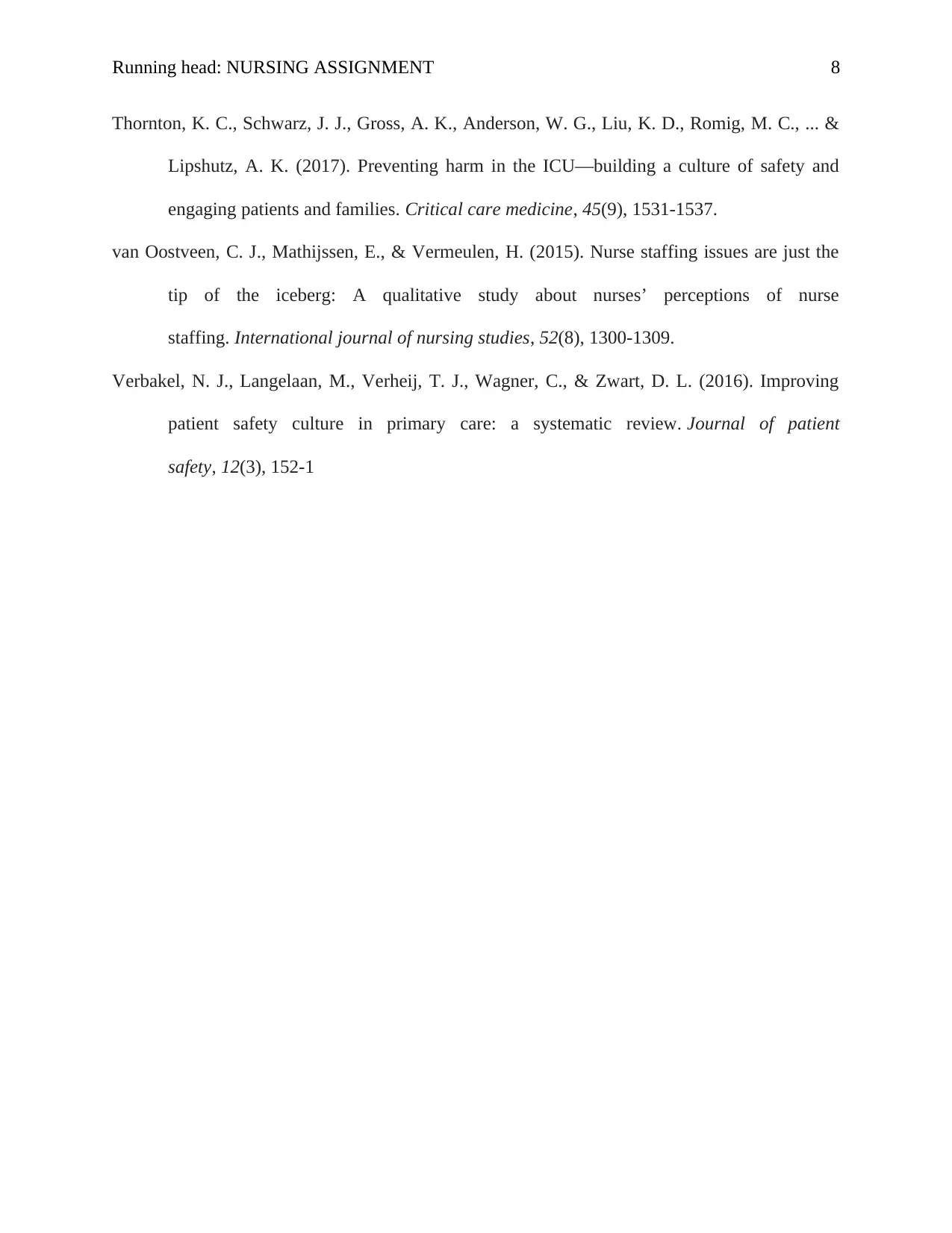
Running head: NURSING ASSIGNMENT 8
Thornton, K. C., Schwarz, J. J., Gross, A. K., Anderson, W. G., Liu, K. D., Romig, M. C., ... &
Lipshutz, A. K. (2017). Preventing harm in the ICU—building a culture of safety and
engaging patients and families. Critical care medicine, 45(9), 1531-1537.
van Oostveen, C. J., Mathijssen, E., & Vermeulen, H. (2015). Nurse staffing issues are just the
tip of the iceberg: A qualitative study about nurses’ perceptions of nurse
staffing. International journal of nursing studies, 52(8), 1300-1309.
Verbakel, N. J., Langelaan, M., Verheij, T. J., Wagner, C., & Zwart, D. L. (2016). Improving
patient safety culture in primary care: a systematic review. Journal of patient
safety, 12(3), 152-1
Thornton, K. C., Schwarz, J. J., Gross, A. K., Anderson, W. G., Liu, K. D., Romig, M. C., ... &
Lipshutz, A. K. (2017). Preventing harm in the ICU—building a culture of safety and
engaging patients and families. Critical care medicine, 45(9), 1531-1537.
van Oostveen, C. J., Mathijssen, E., & Vermeulen, H. (2015). Nurse staffing issues are just the
tip of the iceberg: A qualitative study about nurses’ perceptions of nurse
staffing. International journal of nursing studies, 52(8), 1300-1309.
Verbakel, N. J., Langelaan, M., Verheij, T. J., Wagner, C., & Zwart, D. L. (2016). Improving
patient safety culture in primary care: a systematic review. Journal of patient
safety, 12(3), 152-1
1 out of 8
Related Documents
Your All-in-One AI-Powered Toolkit for Academic Success.
+13062052269
info@desklib.com
Available 24*7 on WhatsApp / Email
![[object Object]](/_next/static/media/star-bottom.7253800d.svg)
Unlock your academic potential
Copyright © 2020–2025 A2Z Services. All Rights Reserved. Developed and managed by ZUCOL.




